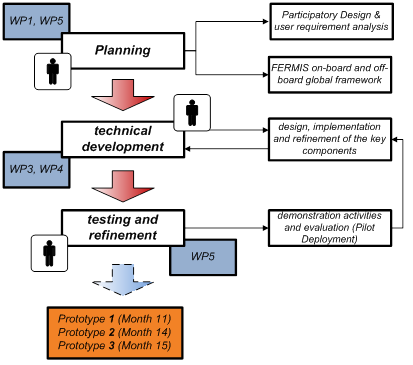Methodology
FERMIS will be developed through a series of relevant stages as described in the following paragraphs. The combination of research at various levels guarantees that all required as-pects are developed in order to establish a robust and highly scalable infrastructure for an open, standard, and interoperable toolset for intelligent UAVs capable of early fire detection and monitoring. In order to assess the FERMIS efficiency, appropriate assessment methodologies will be used. In particular, the assessment phase will involve the project users (provided by KEMEA) in several validation sessions, where the two pilot domains are asked to trial and assess the proposed FERMIS solutions in terms of functionality and efficiency. The system-level integration therefore has to provide proof-of-concept by setting up two validation pilot deployments.
Thus, the project has been divided into three main logical steps, as illustrated in the Figure below:

The overall work plan will be broken down in 5 Work Packages, which are guided by a clearly defined set of project milestones: the first work package (WP1) is dedicated to de-fining all the key specifications and the conceptual architecture of the FERMIS system, by a “User Centred Design” methodology which aims at designing the final solution tailoring it to the end users (experts, decision makers, analysts, fire-fighters, etc.). WP2 to WP4 will be devoted to technological on-board and off-board development, while WP5 to the integration and validation as well as to Impact creation, and Exploitation.
